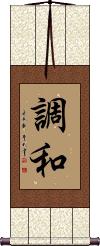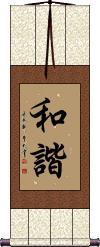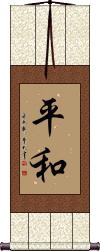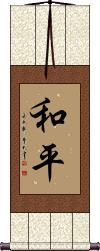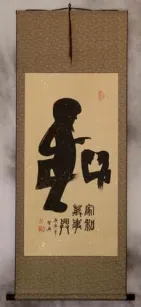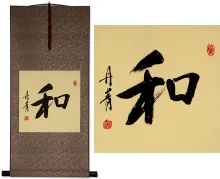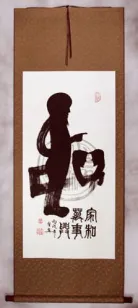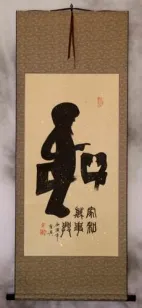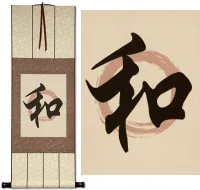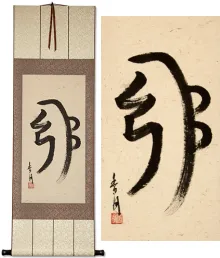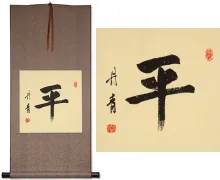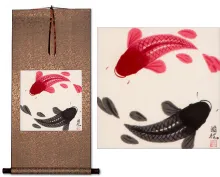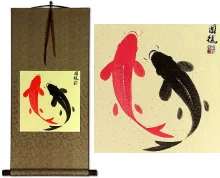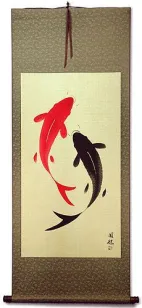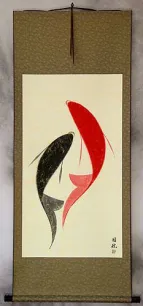Many custom options...
And formats...

Harmony Balance in Chinese / Japanese...
Buy a Harmony Balance calligraphy wall scroll here!
Personalize your custom “Harmony Balance” project by clicking the button next to your favorite “Harmony Balance” title below...
Harmony / Balance
Cho Wa
調和 is one of the several ways to express harmony in Chinese and Japanese.
Note: The first character means harmony but also suggests a musical meaning. It can also describe warriors marching in perfect cadence (in step) or to regulate something.
The second character carries the meaning of harmony and peace by itself.
Together, these characters create a word that can be defined as harmonious, to mediate, to reconcile, to compromise; mediation, temper, to mix, blend, blended, season, seasoning (getting the flavors of the food in balance), to placate, or be in harmonious proportion.
The meaning varies depending on the context. However, when hanging as a wall scroll, this will refer to the person (you) being balanced and in harmony while rational and under control simultaneously.
Harmony / Balance
Life in Harmony / Balanced Life
Harmonious Life
This 和諧生活 title suggests that you have, or want to get your life in balance.
The first two characters regard the idea of balance, harmony, and peace.
The second two characters mean “life.” More specifically this refers to your livelihood, career, and the daily activities that comprise your life or living. Some would translate those two characters as “one's daily existence.”
Note: We have a couple of titles for this idea. This version is more of a noun, thus "The Balanced Life" verses a verb form like "Balancing [Your] Life."
Life in Harmony / Balanced Life
調和生活 is a Japanese title that suggests that you have, or want to get your life in balance.
The first two Kanji mean harmonious or in harmony.
The second two Kanji mean “life.” More specifically this refers to your livelihood, career, and the daily activities that comprise your life or living.
Nature in Balance / Balanced Nature
Peace / Peaceful
平和 is the Japanese and Korean order of these characters used most often to express the idea of peace, tranquility, and harmony.
It's just the reverse order of the Chinese. In this order in Chinese, it means takes the “mild” definition rather than “peace.” In Korean, the combination keeps the same meaning in either order.
The second character also means balance, so there is an element of harmony and balance along with peace.
Peace of Mind
和平 is the Chinese order for these two characters, which means peace but can also be translated as amicability, specifically, or mildness. 和平 is often translated as a simple way to say “peace of mind.” This combination is used in Korean Hanja to mean “peace and harmony.”
Alone, the first character means peace and harmony.
The second character means balance when read by itself.
Note: 和平 are often seen in the opposite order in Japanese with the same meaning (You'll sometimes find them in this order in Japan, so either way is OK).
This in-stock artwork might be what you are looking for, and ships right away...
Blemished Peace / Harmony Special Calligraphy Scroll
Discounted Blemished
Gallery Price: $53.00
Your Price: $29.00
Gallery Price: $53.00
Your Price: $29.00
Gallery Price: $90.00
Your Price: $49.88
Gallery Price: $40.00
Your Price: $16.88
Gallery Price: $60.00
Your Price: $36.88
Gallery Price: $300.00
Your Price: $109.88
Gallery Price: $65.00
Your Price: $39.88
Not the results for harmony balance that you were looking for?
Below are some entries from our dictionary that may match your harmony balance search...
| Characters If shown, 2nd row is Simp. Chinese |
Pronunciation Romanization |
Simple Dictionary Definition |
呼吸 see styles |
hū xī hu1 xi1 hu hsi kokyuu / kokyu こきゅう |
More info & calligraphy: Breathe(n,vs,vt,vi) (1) breathing; respiration; (2) knack; trick; secret (of doing something); (3) harmony; balance; synchronization; accord; (4) (See 一呼吸) short interval; short pause Exhale and inhale. |
均衡 see styles |
jun héng jun1 heng2 chün heng kinkou / kinko きんこう |
More info & calligraphy: Balance / Equilibrium(n,vs,vi) equilibrium; balance |
失調 失调 see styles |
shī tiáo shi1 tiao2 shih t`iao shih tiao shicchou / shiccho しっちょう |
imbalance; to become dysfunctional; to lack proper care (after an illness etc) (1) lack of harmony; lack of balance; lack of coordination; malfunction; (2) {med} ataxia |
取れる see styles |
toreru とれる |
(v1,vi) (1) to come off (of a button, handle, lid, etc.); (v1,vi) (2) to go away (of a fever, pain, swelling, etc.); to disappear; to come out (of a stain); to come off (e.g. of dust); to be removed (e.g. of wrinkles); (v1,vi) (3) to be harvested; to be picked; to be produced; to be caught (of fish); to be obtained; to be extracted; (v1,vi) (4) to be interpreted (as); to be taken (as); to be understood (as); to be read (as); (v1,vi) (5) to be attained (of balance, harmony, etc.); to be achieved; (v1,vi,vt) (6) (potential form of 取る) (See 取る・1) to be able to get; to be able to obtain; to be able to secure; to be able to win; to be able to catch |
釣合う see styles |
tsuriau つりあう |
(v5u,vi) (1) to balance; to be in harmony; to be in equilibrium; (2) to suit; to go well together; to be a good match |
つり合う see styles |
tsuriau つりあう |
(v5u,vi) (1) to balance; to be in harmony; to be in equilibrium; (2) to suit; to go well together; to be a good match |
釣り合う see styles |
tsuriau つりあう |
(v5u,vi) (1) to balance; to be in harmony; to be in equilibrium; (2) to suit; to go well together; to be a good match |
Variations: |
bunshitsuhinpin ぶんしつひんぴん |
(1) (yoji) harmony of beauty and substance; (perfect) balance of looks and character; (2) (yoji) harmony of refinement and simplicity |
Variations: |
osamari おさまり |
(1) conclusion; end; settlement; (2) balance; harmony; fitting (in) |
Variations: |
tsuriau つりあう |
(v5u,vi) (1) to balance; to be in harmony; to be in equilibrium; (v5u,vi) (2) to suit; to go well together; to be a good match |
The following table may be helpful for those studying Chinese or Japanese...
| Title | Characters | Romaji (Romanized Japanese) | Various forms of Romanized Chinese | |
| Harmony Balance | 調和 调和 | chou wa / chouwa / cho wa | tiáo hé / tiao2 he2 / tiao he / tiaohe | t`iao ho / tiaoho / tiao ho |
| Harmony Balance | 和諧 和谐 | hé xié / he2 xie2 / he xie / hexie | ho hsieh / hohsieh | |
| Life in Harmony Balanced Life | 和諧生活 和谐生活 | hé xié shēng huó he2 xie2 sheng1 huo2 he xie sheng huo hexieshenghuo | ho hsieh sheng huo hohsiehshenghuo |
|
| Life in Harmony Balanced Life | 調和生活 | cho wa sei katsu chowaseikatsu | ||
| Nature in Balance Balanced Nature | 自然の調和 | shizen no cho wa shizennochowa | ||
| Peace Peaceful | 平和 | hei wa / heiwa | píng hé / ping2 he2 / ping he / pinghe | p`ing ho / pingho / ping ho |
| Peace of Mind | 和平 | wa hei / wahei | hé píng / he2 ping2 / he ping / heping | ho p`ing / hoping / ho ping |
| In some entries above you will see that characters have different versions above and below a line. In these cases, the characters above the line are Traditional Chinese, while the ones below are Simplified Chinese. | ||||
Successful Chinese Character and Japanese Kanji calligraphy searches within the last few hours...
